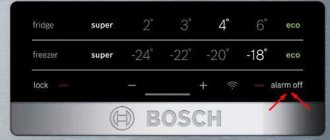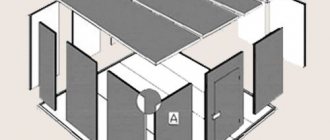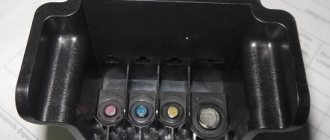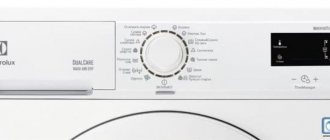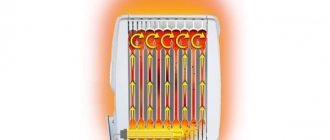The freezer is an excellent solution if you want to ergonomically organize your space, while distributing every centimeter of it. Many people find a rational solution - to place the device outside the already crowded apartment.
The instructions for using the refrigerator indicate that the minimum temperature at which the unit is allowed to operate is +5 degrees.
But housewives often think about a non-trivial question: is it possible to operate a freezer at sub-zero temperatures? To answer it, you will have to consider all the nuances and rules associated with the technical characteristics of operating conditions for refrigeration equipment.
Ideal conditions are from +10 degrees. Failure to comply with this harms the elements of the device, causing them to malfunction: corrosion, damage, oxidation.
Indeed, you can’t just put the device outside and enjoy the process. You will have to foresee a lot, constantly monitor the situation, take care of repairs and wiring.
Features of operating a freezer at sub-zero temperatures
To ensure that your freezer can be operated at sub-zero temperatures, you need to think about the oil that is poured into the compressor. After all, when the frost is -30, its fluidity decreases sharply, which means the motor will not be able to pump freon. The best option in this situation is polyvinyl ester oil.
In the cold, the oil needed to lubricate the parts thickens, there is not enough pressure to move the freon, and the seal bursts.
You should also take the choice of model seriously. Not all manufacturers provide such technical conditions for operation. Therefore, it is worth paying attention to the recommendations of the manufacturer.
If the refrigerator is new, the warranty will not work in this case, because the conditions for storing and using the unit were not met.
Why a freezer in cold weather?
Indeed, during the cold season in many regions of our country, perishable food can be stored on a balcony, loggia, or just outside the window. An ordinary cabinet or suitable drawer is suitable for this. Nature itself will take care of freezing, and completely free of charge.
And yet, for the safety of many types of food products, temperatures around zero are not enough. The packaging of some, in particular meat, products indicates the temperature for long-term storage only when frozen. These values can reach -18°C.
To ensure such conditions, there are household and industrial freezers. These devices do more than just freeze food. It is important to constantly maintain a certain temperature environment, which also contributes to long-term storage.
The principle of operation of the freezer
The freezer operates on the principle of cooling the internal space with refrigerant. As a rule, freon circulates through special tubes. The main components in this device include: an evaporator, a motor, a thermostat sensor, a condenser and a capillary pipe system.
The freezer works on the same principle as a regular refrigerator.
Schematically it can be described as follows.
- The reduced pressure in the evaporator unit causes the refrigerant-generating substance to boil and convert into gas. This reaction occurs with the absorption of heat from the environment, namely from the air located directly in the chamber.
- The motor runs and compresses the vapor from the refrigerant, helping to maintain a high pressure level in the system and forces it into the condenser.
- It is there that the next transition of freon into a liquid state occurs, from where it is again supplied to the evaporator.
- This cycle is repeated many times, resulting in the formation of cold in the freezer.
- The pressure difference, as well as the pumping operation of the engine, ensures the movement of freon in a closed system of capillaries.
The refrigerant that lowers the temperature inside it is most often freon.
Important! The function of the engine itself is supported by oil; it prevents the abrasion of working elements. At low temperatures, this oil can thicken and the main assembly of a complex device simply refuses to continue functioning.
Operating a refrigerator in the cold - is it possible or not: possible problems and malfunctions
We hasten to please the reader with a positive answer. Can. But it's not that simple. An analogy with operating a car in winter is quite appropriate here. That is, the same problems, and the methods for solving them are very similar.
Motorists are well aware of the difficulties of starting an engine at low temperatures . In practice, this is only possible after heating all the process fluids and, first of all, the engine oil.
The refrigerator compressor also contains a special oil, the thickening of which due to prolonged cooling will lead to breakdown of the entire unit. However, during operation, the stator winding of an electric motor generates a lot of heat. The oil in the compressor heats up, and thus ensures normal operating conditions.
The conclusion suggests itself. If a “frozen” refrigerator is placed in a warm room, after some time (from 10 to 20 hours) it can be safely returned to the unheated balcony and immediately turned on.
Another way is to direct a stream of warm air onto the compressor casing directly on site. The negative aspects will be significant energy consumption along with intensive operation of the heating device for several hours.
It is clear that the heating procedure will have to be repeated after each long shutdown of the refrigerator.
However, in order to fully operate refrigeration equipment in winter conditions, just warming up the compressor will not be enough. Below we will consider additional measures and restrictions.
What types of freezers are there?
There are freezers for domestic needs and for industrial purposes. When purchasing, you should pay special attention to its dimensions, general technical characteristics and climate class. It is the last indicator that serves as the key when choosing a unit for uninterrupted, and most importantly, safe operation in extreme conditions.
Some manufacturers produce special climatic freezers that operate at sub-zero temperatures.
- Chest freezers. The main difference is horizontal loading. The internal space is delimited using cells.
- Freezer cabinets. They are front-loading, much more compact, and there are models using the No Frost system. Freezers are much better suited for placement on the balcony and use at low air temperatures.
When choosing equipment, you need to look at the type of installation, chamber capacity, climate parameters and reviews.
Important! Remember that models with a volume of more than 300 liters exceed standard balconies in size, so there is no point in purchasing them.
At what temperature does the freezer operate?
Many people mistakenly assume that since a freezer is capable of freezing food, it means it can easily withstand the cold. However, this opinion is incorrect (although there are exceptions: some models are released with this function).
It should be taken into account that modern devices have characteristic climate classes. They show the ambient temperature range at which the device operates most efficiently.
For example, a freezer with climate class ST means that the equipment will function well only at +10...+32°C.
Before installing a freezer on a balcony in winter, you should study the technical data sheet (most models on the market are designed to operate indoors at room temperature). Failure to comply with this rule, as well as sudden changes in temperature or humidity, may adversely affect the functionality of the freezer and its further operation.
The following climate classes of freezers are distinguished:
- N (moderate). Withstands temperatures in the range of +16…+32°C.
- SN (subnormal). The device operates at +10…+32°C.
- ST (subtropical). For efficient operation of the equipment, the following indicators are required: +18… +38°C.
- T (tropical). The recommended temperature varies between +18…+43°C.
Analysis of climate classes clearly shows that freezers sold on the market are not able to withstand frost. If you place them on a balcony, in a boiler room, in a garage or on the street (at low ambient temperatures), this can lead to equipment failure.
Some sellers distort the description of the product, reporting that the freezer can work anywhere, while maintaining the function of reliable and efficient freezing. However, it is not.
Rules for connecting and installing a freezer on the balcony
Inspired by the idea of saving space, first check whether the plate at the base can support the weight of the refrigeration unit and everything that you are going to place in it, and this is on average 200-300 liters of food. Otherwise, you risk not only the equipment itself, but the integrity of your apartment. Just imagine the storm of emotions among the neighbors below when your balcony collapses under the weight of a device loaded to capacity!
If it is not possible to move it to another room, a glazed loggia or a summer cottage insulated veranda will do.
The basic installation rules can be formulated as follows.
- There should be a distance of at least 5-6 centimeters between the freezer and the wall. This is necessary to ensure sufficient ventilation. Otherwise, the compressor may overheat.
- Please note that any refrigeration equipment, even with low noise levels, vibrates during operation. Therefore, the surface should be leveled using a building level.
- Under no circumstances should you use various extension cords to connect to the electrical network. Therefore, it is necessary to bring the wiring to the balcony and install a separate outlet with grounding.
- There is no need to clutter the surface of the refrigeration chamber by using it as a stand.
- You can build refrigeration equipment into a specially designed cabinet. This will help you organize the space competently and rationally.
The best thing you can do for your unit is to place it in a warm place.
Important! You cannot install any household appliances on an unglazed balcony! This will entail the ingress of moisture and, consequently, the development of corrosion on its surface, in working units, and electrical wiring.
Rules for correct installation
To make using the freezer safe and convenient, you need to inspect the base of the balcony for damage. The stove must withstand the weight of the appliance, the products it contains and other items located on the loggia. If there are significant defects, repair work will be required. When installing and connecting the freezer, the following rules must be observed:
- The device must not be placed close to a wall. To prevent the compressor and other parts of the system from overheating, place the device at a distance of at least 5 cm from other objects
- The freezer body needs to be leveled. This will help reduce the risk of vibrations that negatively affect the base of the balcony.
- Do not connect the device to the network through extension cords and surge protectors. The loggia is wired and a grounded outlet protected from high humidity is installed.
- Do not use the top of the appliance as a shelf for storing any items. This leads to damage to the freezer body.
If necessary, the device can be installed in a pre-prepared cabinet.
The purchase of a household freezer is due to the need to store a large amount of food. The efficiency of the device depends on compliance with the instructions regarding its inclusion, operation, and choice of location. In our article you will find answers to these questions, and also find out at what temperature the device operates, whether it is possible to keep it on the balcony and use it as a refrigerator.
The nuances of the functioning of the freezer at sub-zero air temperatures
There are two important nuances that should be considered before moving on to the implementation of your plan.
- Load-bearing capacity of the balcony slab. If you have PVC metal packages installed, this gives additional load due to their significant weight. Therefore, it is worth carrying out repair work to strengthen the foundation. If you install windows with an aluminum profile, this will significantly lighten the weight of the structure, which means it will create additional opportunities for installing a freezer.
- You will have to change the wiring diagram and connect a special wire with sufficient resistance to the balcony. You will also have to provide a separate grounded outlet. To do this, you can use the services of a professional electrician. If you have sufficient experience, then you should try to install an outlet on your loggia or balcony yourself.
You can help the refrigerator heat the compressor for safe startup, then it will heat itself. For this purpose, fan heaters and heat guns are used.
How to determine the correct temperature setting
Normal temperature conditions are a parameter determined visually. If, when removing containers and bags of food from the freezer, the surface of the package is covered with a thin layer of frost, this indicates that the temperature regime is optimal. The presence of a melted ice crust on the surface of the package, a snow and ice “coat” on the walls of the chamber are signs of an incorrectly set temperature. If food ice in the form of cubes is stored in the freezer, then it can take on the function of an indicator. The edges of the cubes that have melted and lost their sharpness clearly indicate that the temperature in the freezer does not correspond to the storage conditions for the food.
Can a freezer work on a balcony in winter?
To provide the whole family with frozen products, you often have to resort to installing a freezer on the balcony or loggia. The main advantage is obvious - saving space and rational organization of free space. But it is worth remembering that not every freezer is designed for such technical conditions.
It is worth remembering that when storing a refrigerator in the cold, the integrity of many of its components is compromised: seals may crack, electrical circuits may oxidize, etc.
Important! Before placing a freezer on the balcony, make sure that the manufacturer allows the operation of this model at subzero temperatures.
Video MK: cabinet with built-in freezer for a heated balcony
Installing a chest freezer or cabinet is possible only on a carefully landscaped balcony. So that even under these conditions the process of operating the device is not fraught with difficulties, it is necessary to take a responsible approach to the issue of its selection and connection. For the latter, you can invite an electrician. He will carry out all the technical part and give valuable recommendations.
The freezer is used for permanent storage of meat and vegetable preparations. It is purchased when there is no space left in the refrigerator to freeze food. However, the area of the apartment does not always allow placing the device in the kitchen. In this case, users have a question whether the freezer can be placed on an unheated balcony.
What kind of freezer can be installed on the balcony?
It is worth installing only models of cooling units whose engines are filled with oil that retains the ability to flow even under extreme conditions. Otherwise, it will simply become viscous, and you risk incurring huge losses when replacing the freezer motor.
It is best to use the refrigerator in the conditions provided by the manufacturer, which are described in detail in the instructions for the unit.
Based on this, the following are best suited.
- Refrigerators with a special No Frost system or with two compressor motors. They turn on the cooling cycle when the air temperature in the chamber begins to exceed -20 C. Thus, if the air “outside” the refrigerator is warmer, then uninterrupted operation of the unit is quite possible. And in the middle zone, on a glazed balcony, this is exactly the temperature that remains. But the cycles of switching on the device in severe frosts will be rare, and this creates a danger of thickening of the oil in the compressor.
- Freezers and chests. The principle of their operation is not significantly different. They will also include a freon cycle only in conditions where the ambient temperature is above -24 C. In more severe frosts, you risk the serviceability of the refrigeration equipment. To control the situation, you need to install a special outdoor thermometer on the balcony.
Based on this, you can choose a specific model for installation on the balcony. But it is worth remembering that an enclosed space would be the ideal option. And if you are choosing a freezer for an insulated balcony or loggia, you can give preference to any option. The main condition is that the ambient temperature should not fall below 20 C.
Chest freezers and cabinets are recognized as the best in all respects.
Is it possible to place a freezer on a balcony in winter?
Not only the possibility of placing a freezer there, but also the efficiency of its operation and durability depends on the microclimate of the balcony. Balconies, of course, are all different, but according to the degree of livability and appropriate conditions they can be divided into:
- open - without glazing and insulation;
- closed (glazed), but not additionally insulated;
- closed (glazed) and insulated.
Balcony without glazing and insulation
An open balcony means sudden changes in temperature in the off-season, low temperatures in winter, as well as the absence of barriers to precipitation and sunlight. All this is fraught with negative consequences:
- Drying and deformation of the seals, which does not allow the door to close tightly enough.
- Risk of short circuit.
- Corrosion of metal parts of the device.
- Malfunction of the control board.
- Yellowing, cracking and swelling of the decorative coating.
- Increased load on the compressor.
Corrosion process on the surface of the evaporator
Placing a freezer on an open balcony is strictly prohibited!
Glazed balcony without additional insulation
The presence of glazing on the balcony is reliable protection of the household electrical appliance installed there from atmospheric phenomena. However, even the so-called “warm” designs (double-chamber double-glazed windows with a multi-chamber PVC profile) do not allow the temperature of the balcony and the adjacent room to be equalized. It will be only slightly higher than on the street. Are these conditions suitable for installing a freezer in winter?
In most cases, the operating temperature inside it is –18°C. Automation is supposed to start the device at an ambient temperature 2-3 degrees higher. That is, theoretically, the freezer should function at –15°C. But! When the device is turned on under such conditions, the compressor will experience enormous loads.
- Firstly, low temperatures thicken the oil it runs on.
- Secondly, at the stage of freon leaving the condenser, the pressure drops. This stops the circulation of the refrigerant and leads to “idle” movement of the compressor. The result may be rapid failure of this part.
Freezer compressor
Note! If the freezer turns off almost immediately after turning it on, the operating temperature conditions were probably not maintained.
Another argument against using a freezer on a glazed but not insulated balcony is sudden changes in night and day temperatures in the off-season. For reliable and efficient operation of the device, stability of the ambient temperature is important. Otherwise, you risk encountering an undesirable phenomenon such as condensation.
Glazed and insulated balcony
A glazed balcony with additional thermal insulation of walls, floor and ceiling is the only correct option for installing a freezer in this room. In this case, the device is operated at a stable air temperature, almost equal to the values in living rooms. It is also not negatively affected by precipitation.
Operational requirements of the equipment
At what temperature can the refrigerator be operated, and what needs to be provided to install the refrigeration appliance model outside the heated room.
Thanks to its small size, you can place the device on the balcony.
- The temperature should not fall below 20 degrees below zero.
- The supporting slab must be reinforced.
- The vibration level should be leveled. This can be achieved by leveling the surface using a building level.
- The freezer compartment, and especially its electrical components, must not be exposed to precipitation.
- The equipment should not be exposed to direct sunlight.
- In the summer, it is also necessary to take care of the temperature regime; the thermometer should not rise above 32-34 Celsius.
Freezers are vertical devices. They look like real classic refrigerators. Loading of products is carried out frontally.
By following these important operating rules, you can use your freezer absolutely safely. And this will allow you to gain space for storing products.
It must be remembered that, despite the glazing, the air temperature on the balcony should not be lower than +5°C.
Installation and connection rules
Basic Rules:
- A non-frost-resistant device must be placed in a well-ventilated area, shaded and not exposed to temperatures outside the climate class.
- When installing, maintain the required distance from the wall so as not to cover the ventilation grille.
- Place away from heat sources.
- The floor surface must be smooth and hard.
All other recommendations can be found in the operating instructions.
Breakdowns associated with using the refrigerator on the balcony
When operating on a balcony, the following malfunctions of refrigeration equipment may occur:
- Such units cannot withstand overheating above the established standard, the outcome is quite sad: the refrigerant substance heats up and malfunctions.
- On an open balcony, under unfavorable conditions, welds may come apart, which, in turn, will lead to freon leakage.
- When the oil freezes, the “heart” of the device, namely the motor-compressor, can overheat and fail.
- Rubber bands may not withstand high negative temperatures, especially if they are lower than in the freezer itself.
- When snow and moisture get on the start relay, especially during long-term operation in such conditions, corrosion occurs and this will inevitably lead to breakdowns in the refrigerator’s electrical system.
If the refrigerator is on the balcony, you should cover it with plastic wrap. This will protect the device from dust and rain from the street.
Important! Breakage can occur not only due to oil freezing, but also due to direct exposure to sunlight.
Storing a non-working freezer in winter
Sometimes a family needs to store freezer equipment in a non-working state; the best solution is to take it outside the apartment, for example to a loggia, where there is enough free space. Such storage in the summer is possible on open and closed balconies, as well as in winter.
A non-working freezing unit in winter can be installed even on an uninsulated balcony, you just need to carefully pack the equipment and protect it from moisture and dust.
You should carefully select a place for the freezer where slanting rain, other precipitation, dust and dirt will not reach.
Useful tips and tricks
When choosing a freezer, make sure that the compressor oil is polyvinyl ester. Otherwise, in winter it will thicken and the freezer will simply refuse to work. And replacing a compressor will cost you a lot, so it’s better to think about this nuance in advance.
The device must not be installed close to a wall to avoid overheating of the compressor and other parts of the system.
Don't forget that there are electrical safety regulations. Therefore, it is highly not recommended to install refrigeration equipment on an open balcony that is not protected from rain or snow; this will inevitably lead to malfunctions and subsequent additional financial costs. Therefore, if the idea of moving the freezer outside the apartment haunts you, then the balcony or loggia will have to be glazed.
If the temperature on the balcony is below +5 degrees, you need to install additional heating devices or use local heating.
Even having provided for all the difficulties, do not forget to control the operation of the freezer on the balcony. It is important to monitor both the condition of the supporting slab and the ambient temperature. By following these simple rules, you can purchase a freezer and install it on the balcony. And operation at subzero temperatures will not cause any difficulties.
Just remember how to operate the freezer at low temperatures, and then the obstacles will level themselves out.
Basic working conditions
You should know on which balcony you can place the freezer, at what temperature and under what conditions it can work effectively:
- Optimal temperature. This affects not only the functionality of the equipment, but also energy consumption (the cooler the place where the equipment is installed, the less energy it will consume).
- Accommodation. It is not recommended to install refrigerator or freezing equipment in close proximity to heating appliances and systems. An increase in room temperature of 1°C increases the energy consumption of freezers by 3% and refrigerators by 6%. For this reason, they try to place the devices in the coldest part of the house or apartment (and not next to the stove).
- Defrosting. Ice formation in the freezer also increases energy consumption, so it is important to defrost the equipment regularly. On the market you can find models with the No frost system; these systems do not require defrosting, because... they do not form ice.
- You should regularly check the ventilation grilles of freezers and refrigerators to ensure that dust does not accumulate there and air can circulate well. Dust pollution contributes to higher energy consumption, so the grilles must be cleaned twice a year.
- Every time the refrigerator or freezer door is opened, warm air will enter, meaning the system will use more energy to return to the set temperature. For this reason, it is not recommended to keep the household appliance open often and for a long time.
Precipitation penetration
Weather conditions may adversely affect the camera's appearance. An open balcony does not protect the device from precipitation, dust and moisture. With constant exposure to these factors, the operation of the equipment is gradually disrupted, in addition, conditions are created for the development of corrosion.
Exposure to low temperatures
At sub-zero temperatures, most devices do not turn on or work. In addition, frost can greatly affect the integrity of a household appliance.
The appearance of condensation
This phenomenon is especially common in winter on balconies with insufficient thermal insulation. If this room is not properly insulated, condensation may appear on the glass, walls and metal parts of the freezer. Moisture can corrode metal parts and even cause a short circuit.
In addition, excess humidity can negatively affect the protective coating of freezing equipment (gradually destroys the enamel layer).
Temperature
Avoid exposing the device to direct sunlight, as this leads to disruption of its operation (destroys the rubber seals, which, when dry, do not ensure the tightness of the door).
In addition, if the device heats up due to UV rays, the camera begins to function less efficiently (this effect is less pronounced in winter than in summer). To reduce the influence of sunlight, curtains or blinds should be installed on balcony windows.
Freezer type
Some manufacturers make freezers that can withstand extreme temperatures.
What to do if there is nowhere else to put the refrigerator
Sometimes there is nowhere else to put household appliances except the loggia. Before placing a refrigerator on the balcony, think rationally about the situation and take safety precautions seriously. But you can extend the service life of the unit by following the following simple rules:
- Determine the purpose of the device. If you are going to use it to freeze food, then it is better to purchase a freezer. A T or ST class refrigeration device, which is resistant to outdoor heat, can handle storing drinks during the hot season. Also, the temperature difference will not affect dual-compressor models or Full No Frost equipment. Others will fail as soon as the air temperature becomes negative.
- The climate class must correspond to the conditions in which the device is located. A class N refrigerator will not withstand even a season, because it is designed for temperatures not lower than 16 and not higher than 32 degrees.
- If it is lower than +100C outside, then it is better to turn off the equipment, provided that you do not use the freezer. In this way, the service life can be increased.
- To work on loggias and balconies, buy budget models. You can often notice that Soviet models are displayed on the balcony, which are a pity to throw away.
- Due care must be taken to insulate the conductors to avoid fire or short circuit.
The ideal option for operating a household appliance in an unheated room is to heat the area that is intended to be used. In this case, the equipment will work under familiar conditions. If the refrigerator is kept in a warm dacha, then leaving it, you don’t have to worry about violating fire safety conditions.
Preventing possible problems
Sometimes owners have to temporarily store refrigeration devices in garages or cottages because there is no room for them in the apartment. To avoid breakdowns, you must follow these simple rules:
- Before storing, thoroughly wash and dry the unit.
- Monitor the humidity in the room - it should not exceed the norm.
- If there are broken components or spare parts, they should be replaced.
- Maintain your refrigerator regularly.
- To prevent the appearance from being spoiled, apply special protective agents to the surface.
- Remove signs of rust promptly.
- If there is a chemical smell inside the unit, then it can no longer be used.
If there is no urgent need to leave the refrigerator in the cold, then it is better not to do this. Most models are not able to operate at low temperatures. If there is no other way to store the unit, then to maintain performance and extend its service life there are simple recommendations from specialists.
Video: I live in Khrushchevka, and the Kitchen is Small! Where to put the REFRIGERATOR?
I live in Khrushchevka, and the Kitchen is small! Where to put the REFRIGERATOR?
Watch this video on YouTube
Video: How to install a non-built-in refrigerator. Detailed description
How to install a non-built-in refrigerator. Detailed description
Watch this video on YouTube
Do you want to understand better than others?
- Operating instructions for Stinol refrigerators - Download general instructions STD 125 Download instructions STN 167 / STINOL STS 167 Download instructions STN 185 / STINOL STN 185 D Download instructions STN 200 Download…
- Is it possible to install and operate a refrigerator on the balcony in winter - Installing a refrigerator on the balcony allows you to make the kitchen more spacious, but there are some restrictions on the use of such household appliances in unheated rooms...
- Freezer Saratov: operating instructions - Refrigeration equipment produced by domestic manufacturers has proven itself to be of high quality, reliable and consistent with the declared functionality. Review of her models...
- Instructions for operating and setting up a Samsung refrigerator - Samsung refrigerators have long and deservedly been in high demand among consumers all over the world, including in Russia and other CIS countries. Such popularity of this species...
- Operating instructions for a two-chamber refrigerator Minsk - The first Minsk refrigerator was produced in 1962 at a plant located in the capital of Belarus. He is currently part of a team that specializes in…


